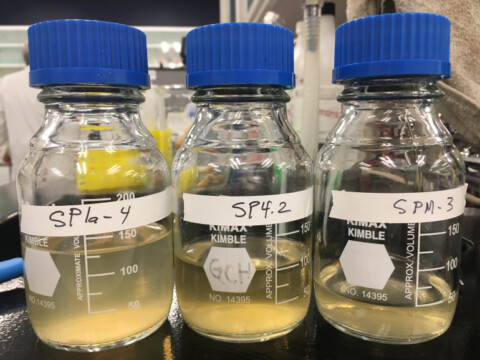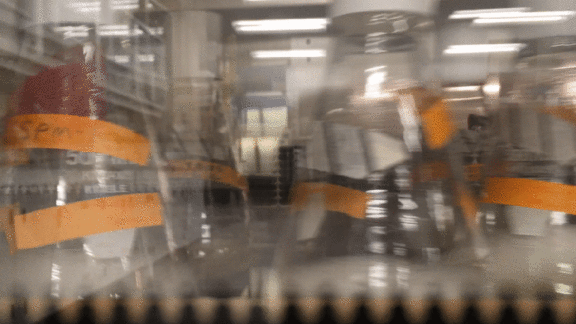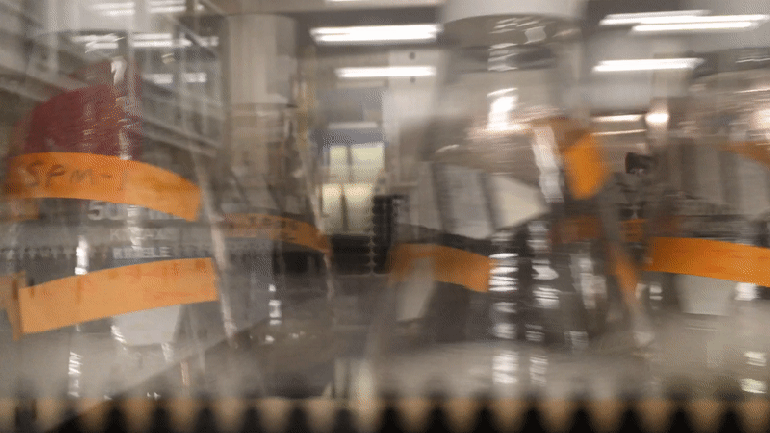ENZYME AGING AND LOSS
Bioart work embraces the ephemeral: investigates it, navigates it and ultimately succumbs to it. Bioart has this life cycle and thus is the venue for probing deep questions around living bodies, life processes and the sublime through materiality.
Recently I conducted more laboratory experiments using the enzymes that Denis and I had produced from our samples of isolated B. cereus. I was using the enzymes to test how much control I could have over enzymatic collagen degradation by using stencils to mask off areas of the collagen plates (areas that would presumably stay intact). A few days later, when I checked on the experiments, I noticed that not much degradation had really happened. This was unusual because typically our enzymes are dramatically effective.
Denis explained to me that enzymes “get old”. These particular enzyme extractions were weeks old by this point, and had become essentially ineffectual. This struck me as ironic, given that I am ultimately using them to create an anti-aging cream, intentionally riffing on the spectacularization of the laboratory apparatus (science) to promote superior products that quell our fears about the ephemerality of our own bodies. My anti-aging enzymes had gotten too old to erase any more wrinkles; they had lost their vigour.

Enzyme-infused face creams are everywhere, and promise wonderful things: skin renewal (“accelerated cell turnover”) through exfoliation, a youthful glow, roseate complexion, attractiveness, self-confidence, freshness and brightness, all antitheses to death and deterioration. Typically the enzymes used in face creams are fruit enzymes such as pineapple, and microbial enzymes are relegated to culturing some of the foods we eat, like yogurt or cheeses. No consumer really knows how long expensive face creams sit on the factory shelf for, before being shipped to a store or eventually purchased. One could safely assume that the enzymes are likely advanced in the aging process by the time they get rubbed onto someone’s hopeful face. I propose, with my work, that it would likely be far better to simply allow someone to lick your face directly, and receive the exfoliating benefits of brand new enzyme secretions being produced as the B. cereus feasts on your skin proteins, and to skip the industry hype.
I want to question the unmediated use of the laboratory apparatus to sell things to people – things like ideas, promises, standards, even morals and ethics. The cultivated distance of science often elevates it to a position of superior knowledge (the impressive unknown, godly), and this gets used for the purposes of profit. Without discrediting, and indeed in favour of true scientific investigation, I want to bring back the closeness, our closeness to our own innate knowledges and materials and our techniques of empathy. I want to show that these are scientifically verifiable, even if weird, and even if they offend our social sense of hygiene, individuality or our interspecies hierarchies.
Backtrack now to my aging anti-aging enzymes: I decided that I had to produce more and repeat my experiments. Today Denis and I got to work on new enzyme production, but alas, discovered that we were at a loss. The -80˚ freezer, which held our precious specimens, had mysteriously swallowed up the prepared tubes and they were nowhere to be found. These specimens were the 1mL frozen liquid cultures of our isolated bacteria, which took weeks to attain in purified form. The one we were particularly interested in was the most effective one, which had been isolated from my saliva, SPM-3. It was just… gone.
Things do go missing in shared labs, such as small equipment, tools, etc but one doesn’t expect or necessarily want controlled biological specimens to go missing. Yet, they often do. There is an immediate suspicion of foul play and to the extreme, of bioterrorism or mutated otherlings taking over sewer systems and destroying humanity (before it destroys itself). In this case, the bacterium would be simply returning to its native habitat in a more concentrated form, were it to be released into the environment, but that was not my concern.
This loss of our specimens means a step backwards, but ultimately forward again, in using a different culture that wasn’t necessarily the best one, but was still one of the saliva-derived ones, to produce a whole new flask of enzymes: SPM-1. Salivam, Take 2.



